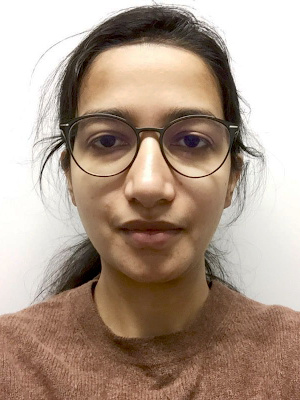| B. Sc. Pooja Malik | |||||||
|
Publications(up to 2022)
-
Raman imaging of atoms inside a high-bandwidth cavity, Phys. Rev. A 105, 043321 (2022)arXivBibTeX ABSTRACT »
ABSTRACT »High-bandwidth, fiber-based optical cavities are a promising building block for future quantum networks. They are used to resonantly couple stationary qubits such as single or multiple atoms with photons routing quantum information into a fiber network at high rates. In high-bandwidth cavities, standard fluorescence imaging on the atom-cavity resonance line for controlling atom positions is impaired since the Purcell effect strongly suppresses all-directional fluorescence. Here, we restore imaging of 87Rb atoms strongly coupled to such a fiber Fabry-Pérot cavity by detecting the repumper fluorescence which is generated by continuous and three-dimensional Raman sideband cooling. We have carried out a detailed spectroscopic investigation of the repumper-induced differential light shifts affecting the Raman resonance, dependent on intensity and detuning. Our analysis identifies a compromise regime between imaging signal-to-noise ratio and survival rate, where physical insight into the role of dipole-force fluctuations in the heating dynamics of trapped atoms is gained.
-
Linewidth-reduced DBR Laser for Raman Sideband Cooling, (2020), Master thesisBibTeX ABSTRACT »
ABSTRACT »In this thesis, I present how the Lorentzian linewidth of a DBR laser was reduced by implementing an external optical feedback path. Chapter 2 deals with the theoretical framework of effects of the external optical feedback on semiconductor laser and regimes of feedback in distributed feedback lasers. To measure and quantify the linewidth of the DBR laser subject to controlled optical feedback, a delayed-self heterodyne (DSH) measurement was setup and is described in Chapter 3. DBR lasers are affected not only by white frequency noise but also low-frequency flicker and random walk noise. These noise components restrict the analysis of the DSH spectrum analytically, hence a simulation based fitting routine based on is used. A comprehensive analysis of the Lorentzian linewidth is presented. An estimate on the linewidth arising from the flicker and random-walk frequency noise is also presented in this thesis. With this improvement to the DBR laser, I present in Chapter 4, the implementation of carrier-free Raman sideband cooling in the main experiment.
Research areas
Our group
Publications
Former research topics
Teaching
Further information
Login
Colloquia
- Curtius Lectures
- 03/05/22 - 06/05/22










